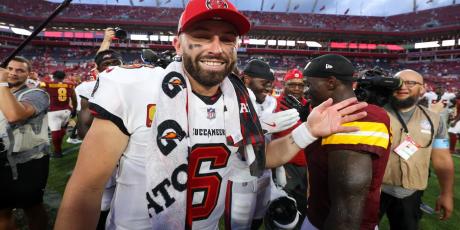How To Approach Pre-Draft MFL10s

There are a few different stages of the off-season, and we are right in the middle of the post-free agency, pre-NFL draft stage. Players like Coby Fleener, Ladarius Green, and Mohamed Sanu have already jumped up a lot in price since free agency started but are starting to settle into their respective draft slots. The next major change coming up April 28th-30th is the NFL draft. The draft will of course greatly impact the rookies, but also the players they will be competing with on their new teams. In this article I will discuss different approaches you can utilize to both capitalize on the draft and avoid unnecessary risks.
How Rookies Impact Each Position
Of all the positions, running backs are most at risk to have their value hurt by an incoming rookie. On the other hand, quarterback situations are usually well known in advance. Even if a team like Dallas drafts a QB to backup Tony Romo, he is at almost no risk (outside of injury) of being replaced this year. Veteran tight ends are usually very low risk as well, as rookies rarely produce at the position.
Wide receivers are an interesting group, as rookies often won’t be directly replacing the top WR on a team, but will be absorbing targets from that receiving corps. The players hurt the most are the fringe WR2s or WR3s on a team. The best example of this effect may be a team like Houston, where if they draft even a decent wide receiver to pair with DeAndre Hopkins, that rookie could replace either Jaelen Strong or Cecil Shorts very quickly. This is true for most teams where if they draft a rookie WR, he could replace a WR flyer you drafted in pre-draft MFL10s.
Pre-Draft Risks
Because running backs tend to be most affected by the draft, here’s a look at some situations where rookies could crush the value of a potential starter.
The most glaring risk, given his price, is Thomas Rawls, who is being drafted as the eighth overall running back in the early third round. Seattle could conceivably draft a top running back and could very quickly replace Rawls as the top RB for the Seahawks. Rawls only had 11 targets out of the backfield all season, so any rookie who can catch the ball and run between the tackles would immediately be more valuable for Seattle.
Currently being drafted right behind Rawls are Doug Martin and Mark Ingram. Both are much safer bets as neither Tampa Bay or New Orleans are likely to draft a running back high this year.
Other running backs of note that could be in danger come NFL draft time are Carlos Hyde, Dion Lewis, Latavius Murray, Jonathan Stewart, Matt Jones, and Jay Ajayi. Though any of these players could remain the top RB on their team, even with a rookie, the risk is there and should be taken into account when drafting.
Rookie Drafting Strategy
There are three ways to approach drafting rookies pre-NFL draft (in order of preference):
- Take a few cheap shots: With this strategy you target cheap rookies as your RB5 or WR7. Guys like Devontae Booker, Alex Collins, and C.J. Prosise have the chance of landing in favorable situations. If they fall to the 15th round or later, I start to think about grabbing them for pure upside. RBs, as mentioned above, can have a great rookie season if they land in the right spot. WRs like Sterling Shepard, Will Fuller, and Leonte Carroo, are super cheap in the 17th round or later as your last or second to last WR. While it’s almost impossible for any rookie to have the breakout that Odell Beckham Jr. had in his rookie year, you can still get some startable weeks in the right conditions, with very minimal risk.
- Avoid rookies altogether: Avoiding all rookies gives you a very stable lineup without the risk of a rookie getting buried on a depth chart. You are missing out on some lottery tickets, and while lottery tickets can return great rewards, they could also be worth nothing. If you find yourself in a draft with a bunch of owners that go rookie heavy, this can really open up some value late in the draft.
- Go rookie heavy: This is when you take players like Ezekiel Elliott in the mid third round and a few WRs like Laquan Treadwell and Josh Doctson in the eighth and tenth rounds, combined with more flyers late like Tyler Boyd, C.J. Prosise, and Michael Thomas. Ending up with a lot of rookies is a really tricky strategy as there are busts every year, and you are greatly increasing your likelihood of a bunch of dead roster spots. Unless you have a rookie class like 2014 (which is very rare), it is very often a losing strategy.
Drafting rookies before they are on a team is interesting to say the least. Just like free agent signings, the rookie’s landing spot greatly affects their opportunity and production for both themselves and other players on the team. Even with the top rookie picks, unless they are cheap enough, there is a fair amount of risk. Last year Todd Gurley was being drafted in the early fourth round as the 18th RB before the NFL draft and his price held steady after the draft. Gurley finished the 2015 season as the seventh highest scoring RB, returning solid value. This year Ezekiel Elliott is currently being drafted as the 12th RB in the mid third round. Elliott has a lot of his upside baked into his price as people look at what Gurley did last year, so tread with caution when drafting a rookie this high.
Two rookies from last year whose prices jumped after the draft based on their landing spots were David Johnson and David Cobb. Both were going in the 16th round or later of MFL10s before the draft in 2015, but jumped up to the 10th round after the NFL Draft. Both had seemingly great opportunities. David Johnson was going to be behind an underwhelming talent in Andre Ellington and David Cobb was going to a team with an unproven Bishop Sankey. David Johnson finished the season as the RB9 while David Cobb finished as the RB130. These two players are extreme examples, but show how taking a chance on lottery tickets before the NFL draft can pay off, and if they do bust they didn’t cost you much anyway. Drafting a David Cobb type rookie in the 17th won’t kill your team, but taking him at an inflated price after the draft may.


















